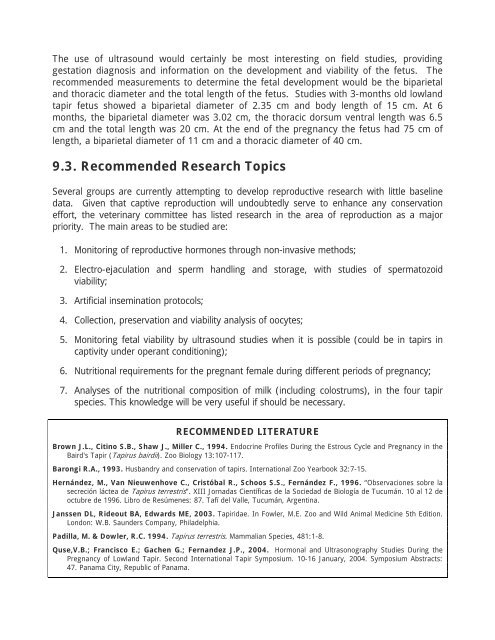TAPIR FIELD VETERINARY MANUAL - Tapir Specialist Group
TAPIR FIELD VETERINARY MANUAL - Tapir Specialist Group
TAPIR FIELD VETERINARY MANUAL - Tapir Specialist Group
Create successful ePaper yourself
Turn your PDF publications into a flip-book with our unique Google optimized e-Paper software.
The use of ultrasound would certainly be most interesting on field studies, providing<br />
gestation diagnosis and information on the development and viability of the fetus. The<br />
recommended measurements to determine the fetal development would be the biparietal<br />
and thoracic diameter and the total length of the fetus. Studies with 3-months old lowland<br />
tapir fetus showed a biparietal diameter of 2.35 cm and body length of 15 cm. At 6<br />
months, the biparietal diameter was 3.02 cm, the thoracic dorsum ventral length was 6.5<br />
cm and the total length was 20 cm. At the end of the pregnancy the fetus had 75 cm of<br />
length, a biparietal diameter of 11 cm and a thoracic diameter of 40 cm.<br />
9.3. Recommended Research Topics<br />
Several groups are currently attempting to develop reproductive research with little baseline<br />
data. Given that captive reproduction will undoubtedly serve to enhance any conservation<br />
effort, the veterinary committee has listed research in the area of reproduction as a major<br />
priority. The main areas to be studied are:<br />
1. Monitoring of reproductive hormones through non-invasive methods;<br />
2. Electro-ejaculation and sperm handling and storage, with studies of spermatozoid<br />
viability;<br />
3. Artificial insemination protocols;<br />
4. Collection, preservation and viability analysis of oocytes;<br />
5. Monitoring fetal viability by ultrasound studies when it is possible (could be in tapirs in<br />
captivity under operant conditioning);<br />
6. Nutritional requirements for the pregnant female during different periods of pregnancy;<br />
7. Analyses of the nutritional composition of milk (including colostrums), in the four tapir<br />
species. This knowledge will be very useful if should be necessary.<br />
RECOMMENDED LITERATURE<br />
Brown J.L., Citino S.B., Shaw J., Miller C., 1994. Endocrine Profiles During the Estrous Cycle and Pregnancy in the<br />
Baird's <strong>Tapir</strong> (<strong>Tapir</strong>us bairdii). Zoo Biology 13:107-117.<br />
Barongi R.A., 1993. Husbandry and conservation of tapirs. International Zoo Yearbook 32:7-15.<br />
Hernández, M., Van Nieuwenhove C., Cristóbal R., Schoos S.S., Fernández F., 1996. “Observaciones sobre la<br />
secreción láctea de <strong>Tapir</strong>us terrestris”. XIII Jornadas Científicas de la Sociedad de Biología de Tucumán. 10 al 12 de<br />
octubre de 1996. Libro de Resúmenes: 87. Tafí del Valle, Tucumán, Argentina.<br />
Janssen DL, Rideout BA, Edwards ME, 2003. <strong>Tapir</strong>idae. In Fowler, M.E. Zoo and Wild Animal Medicine 5th Edition.<br />
London: W.B. Saunders Company, Philadelphia.<br />
Padilla, M. & Dowler, R.C. 1994. <strong>Tapir</strong>us terrestris. Mammalian Species, 481:1-8.<br />
Quse,V.B.; Francisco E.; Gachen G.; Fernandez J.P., 2004. Hormonal and Ultrasonography Studies During the<br />
Pregnancy of Lowland <strong>Tapir</strong>. Second International <strong>Tapir</strong> Symposium. 10-16 January, 2004. Symposium Abstracts:<br />
47. Panama City, Republic of Panama.










